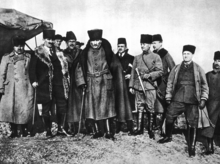반품(경제학)
Returns (economics)경제 및 정치 경제에서 수익은 재화나 용역의 다양한 공급자에게 주어지는 분배 또는 지급이다.
임금
임금은 노동으로 복귀하는 것이다. 즉, 재화나 용역의 창출이나 실현에 있어서 개인의 관여(정신적 또는 물리적)로 복귀하는 것이다. 임금은 공급자가 자신일지라도 노동의 개별 공급자에 의해 실현된다. 개인소비를 목적으로 국유림에서 버섯을 채취하는 사람은 버섯 형태의 임금을 실현하는 것이다. 임금 지불자는 한 명 이상의 개인이 수행하는 서비스에 대해 지불하고 있으며, 임금을 비용으로 간주한다.
렌트
고전경제학에서 임대료는 토지의 "소유자"에게 돌아가는 것이었다. 후기 경제 이론에서 이 용어는 장벽에서 진입까지 전형적으로 실현되는 다른 형태의 불로소득을 포함하도록 경제 임대료로 확대된다. 토지 소유자는 생산 과정에 아무런 기여도 하지 않기 때문에 토지 소유는 진입 장벽으로 간주된다. 그들은 단지 다른 사람들이 그렇지 않으면 유용할 수 있는 것을 사용하는 것을 막는다.
Interest
The classical economists referred to the fee paid for the use of money or stock as "interest" but declared this to be a derivative income. The distinction between interest and profit is murky:
"Whoever derives his revenue from a fund which is his own, must draw it either from his labor, from his stock, or from his land. The revenue derived from labor is called wages. That derived from stock, by the person who manages or employs it, is called profit. That derived from it by the person who does not employ it himself, but lends it to another, is called the interest (f)or the use of money (or stock). It is the compensation which the borrower pays to the lender, for the profit which he has an opportunity of making by the use of the money (or stock). Part of that profit naturally belongs to the borrower, who runs the risk and takes the trouble of employing it; and part to the lender, who affords him the opportunity of making this profit. The interest of money is always a derivative revenue, which, if it is not paid from the profit which is made by the use of the money, must be paid from some other source of revenue, unless perhaps the borrower is a spendthrift, who contracts a second debt in order to pay the interest of the first." (Smith[1])
Smith uses the word profit in two different ways here. Is the owner of the money/tractor in his capacity as owner realizing profit or interest? It is certain that the proprietor of the money/tractor is realizing profit as opposed to interest. See "Smith on Profits and Interest" below.
Profit
In Classical Economics profit is the return to the proprietor(s) of capital stocks (machinery, tools, structures). If I lease a backhoe from a tool rental company the amount I pay to the backhoe owner it is seen by me as "rent". But that same flow as seen by the supplier of the backhoe is "interest" (i.e. the return to loaned stock/money).
For the individual who rented the backhoe from the rental company, profit is the wages that would have been required excavating by hand, minus the rent paid for the backhoe, minus the smaller amount of wages required using the backhoe. Gross profit is value of result minus rent or depreciation. Real profit is what remains after I pay for the operation of the backhoe.
The Wealth of Nations에서 아담 스미스는 이익과 이자에 대해 다음과 같이 말했다.
그러나, 사회의 자본 주식이나 산업의 유지에 필요한 자금의 감소는 노동의 임금을 낮추기 때문에 주식의 이익을 높이고, 결과적으로 돈의 이자를 증가시킨다. 노동의 임금이 낮아지면 사회에 남아 있는 주식의 소유주들은 전보다 적은 비용으로 그들의 상품을 시장에 내놓을 수 있고, 이전보다 시장 공급에 덜 고용된 주식들은 그것들을 더 잘 팔 수 있다. 그들의 상품은 비용이 적게 들었고, 그들은 더 많은 돈을 벌었다. 그러므로 그들의 이익은 양끝에 증대되어 큰 이자를 감당할 수 있다. 벵골과 동인도네시아에 있는 다른 영국 정착촌에서 너무나 갑작스럽고 쉽게 획득된 큰 행운은 노동의 임금이 매우 낮기 때문에, 그 폐허가 된 나라들에서 주식의 이윤이 매우 높다는 것을 우리에게 만족시킬 수 있을 것이다. 돈의 이자는 비례해서 그렇다. 벵골에서는 40,50,60%의 비율로 농부들에게 자주 돈을 빌려주고 그 대금을 위해 후속 작물을 저당 잡힌다. 그러한 이자를 감당할 수 있는 이윤은 집주인의 집세를 거의 다 먹어 치워야 하기 때문에, 그렇게 엄청난 고리 대금은 그 이익의 대부분을 먹어 치워야 한다. 로마 공화국이 멸망하기 전, 같은 종류의 고리대금은 그들의 프로콘솔들의 파멸적인 행정 아래 지방에서는 흔했던 것 같다. 덕망 있는 브루투스는 키케로의 편지로부터 배운 대로 키프로스에서 8불과 2불의 비율로 돈을 빌려주었다.[2]
신고전주의 경제학
신고전주의 경제학에서 이윤은 총투자실적이며 경제적 임대료를 포함한다.
총투자수익률
투자성과라고도 하는 총투자수익은 직접수익(배당금, 이자...)과 자산시장가치의 변동에 따른 자본이익(감소자본손실)을 포함한다.


